Tele-Mental Health: My Therapist Knows My Dirty Laundry (Literally!)
We’re in the midst of the quarantine, and the days are blending together. The pressure to be pleasant and productive while staring into Zoom all day is mounting for many remote workers. Unemployment has negatively affected hundreds of thousands, and the down time feels like wandering a cage, walking in circles, back and forth from the kitchen, to the laundry, to changing kitty litter, then back to pick up random take-away from the front door (if the budget allows). Throw in a shower and a Facetime, and we do it all again the next day. For many, the decision to book a session with a therapist is a signal that they have had enough and are ready for a change. We are ready and trained to hear the story, manage the symptoms, and to offer hope.
Fleurish therapists have adapted to provide therapy remotely, using HIPPA compliant software that ensures clients’ safety is never in doubt. Although video therapy is a change that comes at the cost of physical closeness, we believe that these digital platforms are necessary and effective tools that allow us to support our clients without exposing one another to potential infection. In these unprecedented times, video-therapy allows us to be flexible, and adaptable to your changing schedule.
Caitlin Rattigan, LCSW, has enjoyed and adapted well to the move to tele-mental health. She asked her clients what they like about the new platform and here are some of things she is hearing from them:
Clients can finally take their time getting ready for a more convenient, video session. You can easily throw in a load of laundry or start cooking food in a crockpot right before a session, and after your session pick up right where you left off.
You can make your own Zen space for sessions by making a cup of tea, burning a candle, and snuggling up in a blanket with a pet nearby. Talk about self -care vibes!
Clients can avoid logistical stress of heavy traffic, looking for parking, or dealing with anxiety of not knowing what to expect going into a new social environment.
Clients’ parents, family, and friends are becoming curious about therapy themselves, after seeing how easy it can be to get started. Not only are my clients gaining better communication and coping skills, so are their family and friends.
I, Laura McMaster, LMFT, have seen the positives of tele-mental health, noting that therapists can excel at facilitating the more intellectual parts of discussion and analysis over video conference. Though online therapy is different from the way I trained, I encourage other therapists to adapt to what this change could offer to your sessions.
I’ve enjoyed claiming my workspace and welcoming people into my home office. The Zoom background is a natural conversation starter, whether you choose to use one or not. It’s been a relief to talk to clients coming from a place where I am comfortable and can provide welcoming energy.
Similar to Caitlin’s points, therapists welcome extra time to prepare themselves, rest up, and center before entering session.
In the great shift to remote work, I agree with the headlines that video conference is a particularly strong modality for providing individual therapy. Looking inward might be even more likely when the therapist is at a distance, providing space for clients to consider their history and choices.
Shifting exclusively to video-therapy could prove troubling for couples and group work because the energy and small behaviors of others feeds those interventions. Similarly, when the pandemic subsides, individual-therapy models could shift to a hybrid style in which most clients start in-person, but parties could appreciate the flexibility of video conference when either the therapist or client requests.
Stay with the Fleurish blog to read more about psychotherapy in a changing landscape.

